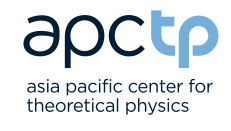Speaker
Description
Masses and spins of hadrons are fundamental quantities in physics; however, their origins are not understood yet and their investigations are major purposes of building electron-ion colliders for physics in 2030's. Both of them can be investigated by generalized parton distributions (GPDs). The spacelike (timelike) GPDs are studied by deeply virtual Compton scattering (two-photon processes) at charged-lepton accelerator facilities ($e^+ e^-$ collider facilities) such as the JLab, CERN-AMBER, and EICs (KEKB). Since the GPD studies by the charged-lepton scattering should be covered by other speakers, I discuss other experimental prospects at the $e^+ e^-$ collider KEKB, the hadron-accelerator facility J-PARC, and the Long-Baseline Neutrino Facility (LBNF) at Fermilab. It is possible to extract the timelike GPDs and gravitational form factors of hadrons by the two-photon processes $\gamma^* + \gamma \to h + \bar h$, where $h$ is a hadron. Actually, there was the first report on the determination of the gravitational form factors and radii (mass and mechanical radii were 0.32-0.39 fm and 0.82-0.88 fm for $\pi^0$) from actual experimental measurements in Ref.[1]. At J-PARC, the GPDs will be investigated by the exclusive Drell-Yan process $\pi^- p \to \mu^+ \mu^- B$ [2], where the baryon $B$ could be a nucleon or $\Delta$. In future, other processes could be investigated for the GPDs. For example, the $2 \to 3$ reaction processes $NN \to N \pi B$ could be used for probing the GPDs in the ERBL (Efremov-Radyushkin-Brodsky-Lepage) region [3]. In addition, the neutrino facility Fermilab-LBNF can be used for the GPD measurement by the single-pion production processes $\nu + N \to \ell^- + N' + \pi$ and $\bar\nu + N \to \ell^+ + N' + \pi$ [4].
There was recent theoretical progress on transverse-momentum-dependent parton distribution functions (TMDs) and parton distribution functions (PDFs) for spin-1 hadrons, such as the deuteron, at twists 3 and 4 [5]. We showed that 30 new structure functions and also new fragmentation functions exist at twists 3 and 4. Integrating the TMDs over the transverse momentum, we found new collinear PDFs. Then, we derived a twist-2 relation and a sum rule for the tensor-polarized PDFs $f_{1LL}$ and $f_{LT}$, and we also showed that twist-3 multiparton distribution functions $F_{LT}$, $G_{LT}$, $H_{LL}^\perp$, and $H_{TT}$ exist. Relations among these collinear parton- and multiparton-distribution functions were derived by using the equation of motion for quarks. These studies will be useful in future investigations on the spin-1 structure functions. We expect that the field of structure functions for spin-1 hadrons will become a hot topic in the near future because of experimental projects at the JLab, the Fermilab, the NICA, the LHCspin, and the electron-ion colliders in US and China.
References
[1] S. Kumano, Qin-Tao Song, and O. V. Teryaev, Phys. Rev. D 97, 014020 (2018).
[2] T. Sawada et al., Phys. Rev. D 93, 114034 (2016); J-K. Ahn et al., Letter of Intent for J-PARC, LoI_2019-07; Wen-Chen Chang et al., J-PARC proposal under preparation.
[3] S. Kumano, M. Strikman, and K. Sudoh, Phys. Rev. D 80, 074003 (2009).
[4] S. Kumano and R. Petti, Proc. of Science, NuFact2021, 092 (2022).
[5] S. Kumano and Qin-Tao Song, Phys. Rev. D 103 (2021) 014025; JHEP 09 (2021) 141; Phys. Lett. B 826 (2022) 136908.

